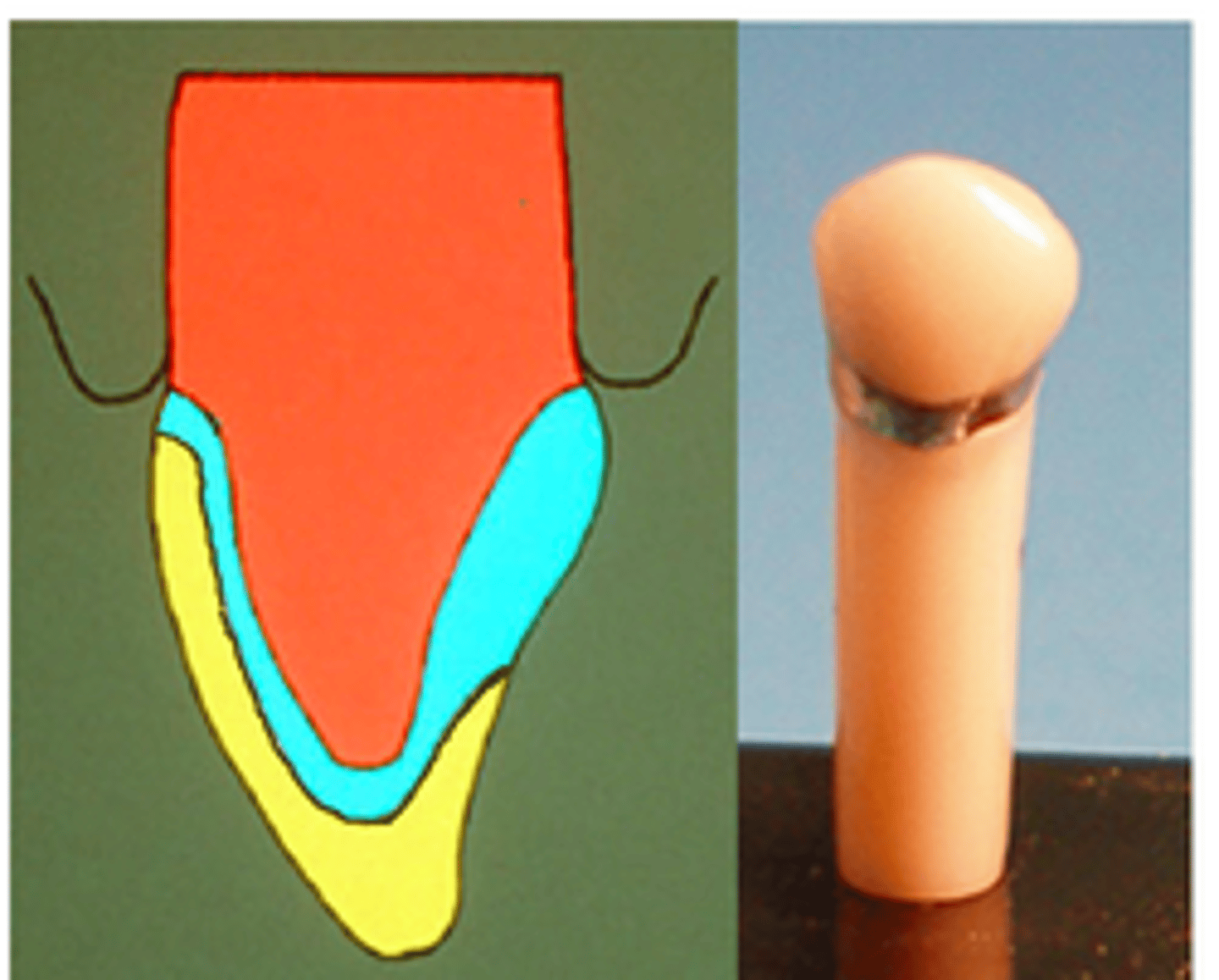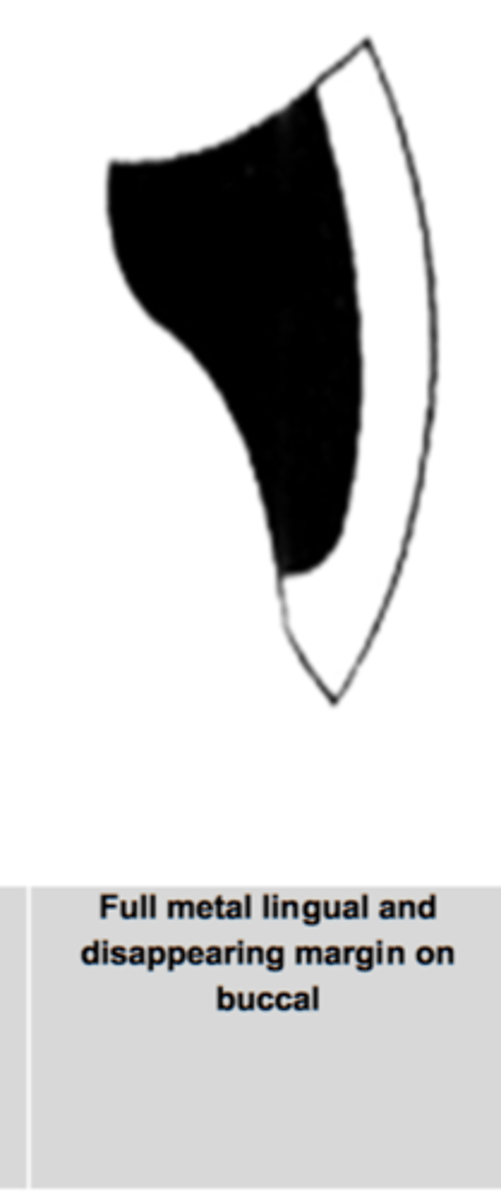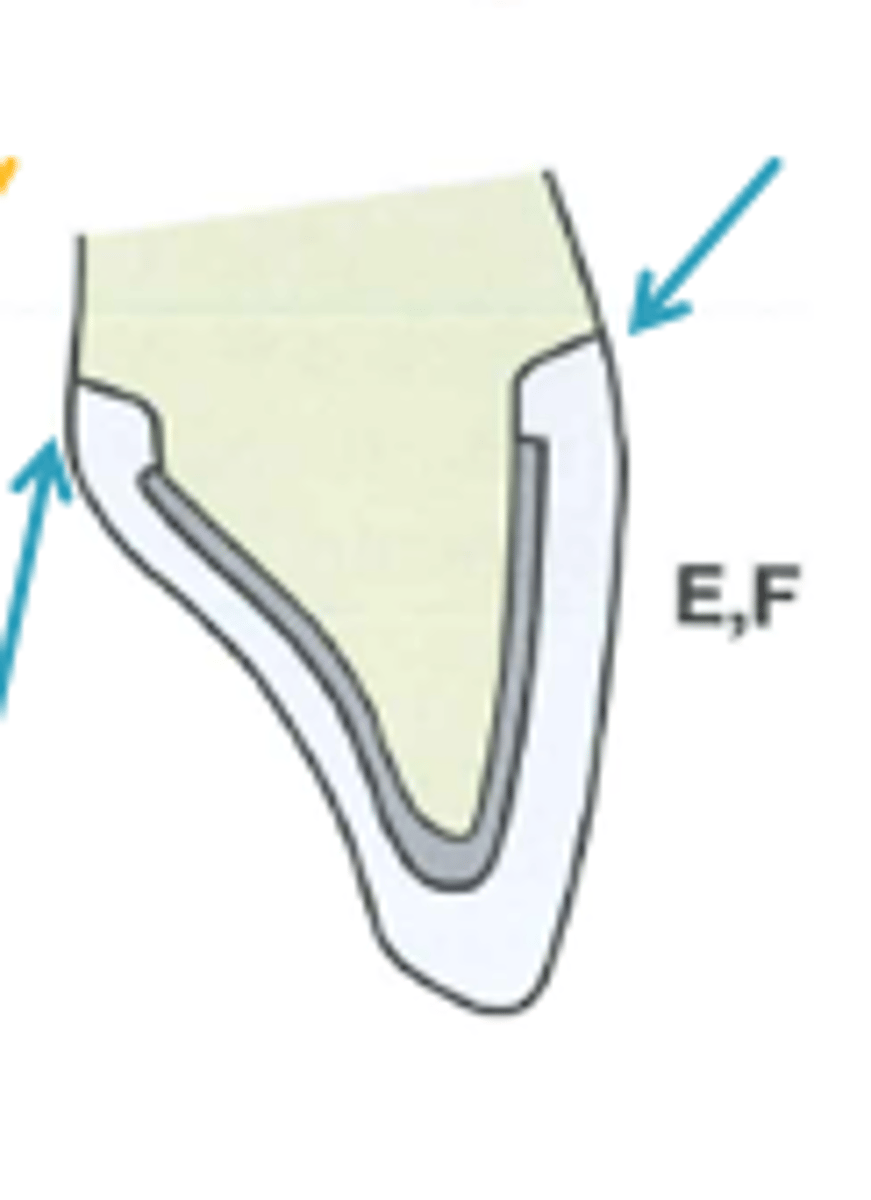Porcelain Fused to Metal Restorations
1/54
There's no tags or description
Looks like no tags are added yet.
Name | Mastery | Learn | Test | Matching | Spaced |
|---|
No study sessions yet.
55 Terms
metal-ceramic restoration
what combines the strength and accuracy of cast metal with the esthetics of porcelain; known for predictable esthetics and sound physical properties, most popular in 1970's and 80's
porcelain fused to metal
consists of a complete cast metal substructure and porcelain veneered for esthetics --> aggressive restoration to mask metal substructure
- esthetics
- long span fixed partial dentures (due to strength at the connectors)
- abutment teeth for removable partial dentures
what are the indications for a PFM
- patients with untreated perio disease
- young patients with large pulp chambers
- bio-incompatibility: some patients are allergic to metals
what are the contraindications for a PFM
0.3-0.5mm
how thick is the metal coping layer of a PFM
opaquer
layer of a PFM the conceals the metal and develops bond between metal and porcelain
0.8-1mm
how thick is the body and incisal (or occlusal) porcelain layer of a PFM
1.1-1.5mm
what is the overall required thickness for porcelain veneered surfaces
dentin
what does body porcelain represent that is more opaque
enamel
what does the occlusal porcelain represent that is more translucent
no function on the junction
what is the saying to determine where the junction of metal and porcelain should be placed in reference to occlusion
1.5mm
how far away should the metal-ceramic interface be from all centric occlusal contacts
color of the underlying body and opaque porcelain
what significantly influences the perceived color of the PFM restoration
gold based
palladium based
what are the noble metal casting alloys for PFM that have good corrosion resistance due to inherent nobility
nickel
cobalt
chromium
titanium
what are the base metal casting alloys for PFM
nickel
cobalt
what are the principal elements of base metal casting alloys for a PFM
chromium
titanium
what base metal casting alloys oxidize rapidly and prevent diffusion of oxygen into the underlying metal (protects it from corrosion) but these oxides could cause greenish color of porcelain
silver
copper
gallium
what may also be included in base metal casting alloys that are not noble metals and could cause greening of porcelain if present
oxide layer
what forms during casting and should be partially removed (either by acid or airborne particle abrasion with aluminum oxide)
controlled oxide layer
what creates surface irregularities to help with mechanical bond besides chemical bond between porcelain and metal (want this to be thin after partially removing)
manufacturers incorporate small amounts of certain base metals that form ___ to aid chemical bonding to metal-ceramic adherence
linear coefficient of thermal expansion
what must closely match between the metal and ceramic to achieve a strong interfacial bond
porcelain-alloy bonding
"wetting" the alloy surface by the porcelain slurry at the firing temperature (opaque layer)
dental porcelain
chemically speaking are glass:
- quartz (SiO2)
- Feldspar (potassium aluminum silicate, orthoclase, sodium aluminum silicate albite)
- other oxides
- a firing temp well below the melting range of the metal
- a significantly high thermal expansion compatible with the metal
what are 2 requirements for porcelain that will be fused to a metal for a PFM
if oxide layer not formed
what is a mode of failure of porcelain-metal restorations
fracture during bisque bake
what failure is caused by:
- improper condensation
- improper moisture contol
- poor framework design
- incompatible metal-porcelain combination
bubbles
what failure is caused by:
- too many firings
- air entrapment during buildup of restoration
- improper moisture control
- poor metal preparation
- poor casting technique
unsatisfactory appearance
what failure is caused by:
- poor communication with technician
- inadequate tooth reduction
- excessive thickness of opaque porcelain
clinical fractue`
what failure is caused by:
- excessive firing
- poor framework design
- centric stops too close to metal-ceramic interface
- improper metal preparation
1.5mm
how much occlusal reduction is necessary for a metal occlusal PFM
2.0mm
how much occlusal reduction is necessary for a porcelain occlusal PFM
1.5-2mm
how much occlusal reduction is necessary for combination occlusal PFM
metal collar margin
what type of PFM margin is this called (usually on the lingual)

- disappearing metal margin
- porcelain margin
- metal collar margin (on lingual usually)
what are the 3 kinds of margins for a PFM
disappearing metal margin
what PFM margin has a combination of metal and porcelain that should have a 120 degree sloped shoulder margin
- usually on the buccal to conceal the metal portion of a PFM

120 degrees
how sloped should the shoulder of a disappearing metal margin be?
90 degrees
how sloped should the shoulder of a porcelain margin be?
porcelain margin
what PFM margin is used when better esthetics are desired

conservation
avoid weakening of the tooth
resistance
prevent dislodgment apical or obliquely directly forces
retention
prevent displacement along the path of insertion or long axis of the tooth
structural durability
provide adequate reduction for material strength
margin
proper finish line for close adaptation; minimize leakage
periodontium
provide proper shape and contours for optimal periodontal health
1/3 buccal axial wall
how large is the aesthetic bevel and where is it placed
878-012
878-014
878-016
What are the numbers for a chamfer bur?
chamfer margin
what margin is used for the lingual margin of the #4 PFM prep
functional bevel
what provides adequate space and thickness of the restorative material on the area of significant functional loading
mesial contact
how far in the buccal margin extended interproximally since its more visible?
847-016 (flat end taper)
what bur is use to establish the 120 margin for a disappearing metal margin
10839-012
10839-014
10839-016
what are the codes for end cutting burs to establish your 120 degree sloped margin
just lingual to the contact
where is the mesial shoulder to chamfer transition for the 14 PFM prep
just lingual to the DB line angle
where is the distal shoulder to chamfer transition for the 14 PFM prep
847
what bur do you use for the facial margin of a PFM prep
878
what bur do you use for the lingual margin of a PFM prep